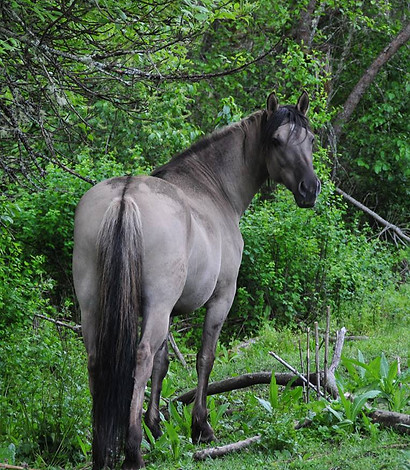INTERNATIONAL ALLIANCE of KIGER BREEDERS

KIGER BREED STANDARD
OVERALL IMPRESSION
The Kiger is “baroque” in nature due to its round body contours with the neck arising from the top of the shoulder giving them an elegant, collected stance. The Kiger should be balanced in proportions and should move with ease and without wasted energy. The Kiger, on one hand, should give an impression of strength without being bulky while on the other should not be so refined as to convey frailty or extreme refinement.
HEIGHT
13.2 to 16 Hands (Preferred is 14 to 15.2). It has been observed that Kigers bred in captivity attain a higher height than those Kigers from the wild range. (this may be nutritional)
QUALITY
The Kiger should have clean, dense bone with sufficient substance, well developed joints and tendons, with a fine body coat, tractable temperament but with good spirit.
COLOR
Variations of the Dun factor color: Dun, Red Dun, Grulla, Claybank, Bay & Black.

FOREHAND
Long shoulder at 45-50 degree slope, blending smoothly with withers. The withers are slightly higher than the point of the hip; well defined but not prominent. Forelegs should be moderately spaced with an inverted V appearance, however, without giving appearance of bulky chest muscling. Muscles in the shoulder and forearm should be long and lean. The legs should be correct; viewed from the side, legs should be wide and lean.
BARREL
The body conformation of the Kiger is distinctive, with a deep chest, short back, broad and moderately muscled. The barrel is oval, with well-sprung ribs, and a full flank. The sternum should not protrude.
HINDQUARTER
The hind legs should be squarely set and so placed that the Kiger turns on his hindquarters with ease. The hips should be lightly rounded, with croup sloped gently with medium-low set tail. Muscles in the hip and thigh should be long and lean. The hocks should be wide, deep and clean. Viewed from the rear, the hind legs are usually closer at the hocks than the fetlocks, but not to the extreme.


MARKINGS
A dorsal stripe is mandatory on all Dun, Red Dun, Grulla and Claybank colors and desirable on all Bays & Blacks. Dorsal stripes may be difficult to see or photograph on some Bay and Black body colored horses. Herringbone stripes radiating from the dorsal are highly desirable. Leg barring should be present and expression can range from dark lacing to strong bars. Additional highly desirable dun factor markings include: wither stripes, shadows and bars on neck and chest, barring on the back of the ear, dark marks around the rim of the eye, dark line along the margin of the ear with dark tips, cobwebbing and/or sooty or shadow mask on the face. Mane and tail should be full with moderate bi-coloring preferred. All colors including Bay and Black must have lighter colored hair inside the ear.
HEAD
Medium in size, clean cut and tapering slightly from jaw to muzzle. Head should be balanced and not overly refined. The profile side view can be straight, slightly sub-concave, or slightly sub-convex. Wide, clean cut lower jaw, medium fine muzzle with small and firm lips and medium nostrils. Ears should be medium in length, hooked at the tips on the inside and set wide apart and carried alert.
NECK
Medium length, arched, clean at the throat latch, joined smoothly at the shoulder and deep at the point of the shoulder.

CANNON
Short to medium, wide and flat with tendons standing well out from the bone and well defined.
PASTERN
Pasterns should be clean and strong, of medium length, the slope to correlate with the slope of the shoulder. Fetlock joint should not be round, but rather wide. Fetlocks should be scarce of feathering.
HOOVES
The hoof is dense with thick walls and recessed sole and frog. The Kiger hoof tends to be round to oblong, be of medium size, and have more heel and steeper hoof angles. The Kiger should have dark hooves.
ACTION
Light, lively, tending toward higher than average leg action.
IAKB
